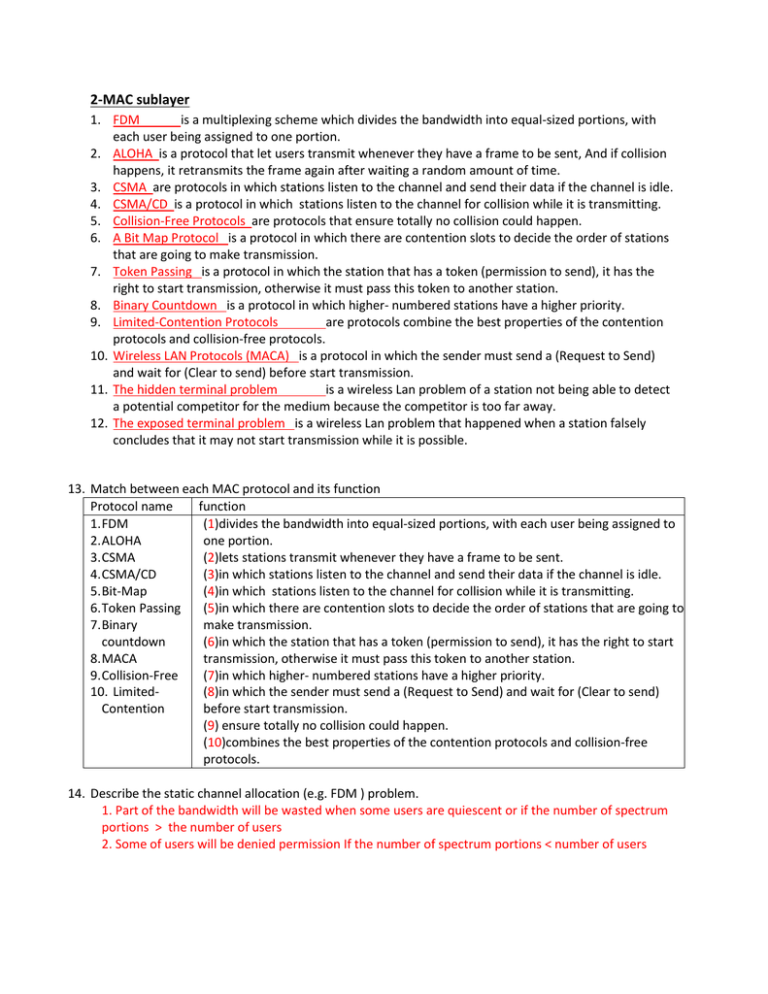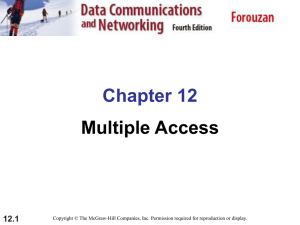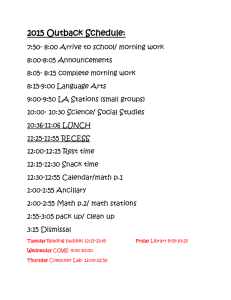بنك اسئلة2
advertisement

2-MAC sublayer 1. FDM is a multiplexing scheme which divides the bandwidth into equal-sized portions, with each user being assigned to one portion. 2. ALOHA is a protocol that let users transmit whenever they have a frame to be sent, And if collision happens, it retransmits the frame again after waiting a random amount of time. 3. CSMA are protocols in which stations listen to the channel and send their data if the channel is idle. 4. CSMA/CD is a protocol in which stations listen to the channel for collision while it is transmitting. 5. Collision-Free Protocols are protocols that ensure totally no collision could happen. 6. A Bit Map Protocol is a protocol in which there are contention slots to decide the order of stations that are going to make transmission. 7. Token Passing is a protocol in which the station that has a token (permission to send), it has the right to start transmission, otherwise it must pass this token to another station. 8. Binary Countdown is a protocol in which higher- numbered stations have a higher priority. 9. Limited-Contention Protocols are protocols combine the best properties of the contention protocols and collision-free protocols. 10. Wireless LAN Protocols (MACA) is a protocol in which the sender must send a (Request to Send) and wait for (Clear to send) before start transmission. 11. The hidden terminal problem is a wireless Lan problem of a station not being able to detect a potential competitor for the medium because the competitor is too far away. 12. The exposed terminal problem is a wireless Lan problem that happened when a station falsely concludes that it may not start transmission while it is possible. 13. Match between each MAC protocol and its function Protocol name function 1. FDM (1)divides the bandwidth into equal-sized portions, with each user being assigned to 2. ALOHA one portion. 3. CSMA (2)lets stations transmit whenever they have a frame to be sent. 4. CSMA/CD (3)in which stations listen to the channel and send their data if the channel is idle. 5. Bit-Map (4)in which stations listen to the channel for collision while it is transmitting. 6. Token Passing (5)in which there are contention slots to decide the order of stations that are going to 7. Binary make transmission. countdown (6)in which the station that has a token (permission to send), it has the right to start 8. MACA transmission, otherwise it must pass this token to another station. 9. Collision-Free (7)in which higher- numbered stations have a higher priority. 10. Limited(8)in which the sender must send a (Request to Send) and wait for (Clear to send) Contention before start transmission. (9) ensure totally no collision could happen. (10)combines the best properties of the contention protocols and collision-free protocols. 14. Describe the static channel allocation (e.g. FDM ) problem. 1. Part of the bandwidth will be wasted when some users are quiescent or if the number of spectrum portions > the number of users 2. Some of users will be denied permission If the number of spectrum portions < number of users 15. Compare between ALOHA and SLOTTED ALLOHA by (a)how they work, (b) channel utilization, (c) delay? 1-persistent CSMA nonpersistent CSMA how they work If the stations transmit whenever A station (ready to send) waits for the channel is busy, they have data to be sent beginning of the next slot. channel utilization Better channel utilization (less collisions) delay lower delay with low load lower delay with high load 16. Compare between 1-persistent CSMA , nonpersistent CSMA , by (a)how they work if the channel busy, (b) channel utilization, (c) delay? 1-persistent CSMA nonpersistent CSMA how they work If the stations (ready to send) stations (ready to send) waits a channel is busy, continuously sense it for random period of time before sense it collision. again. channel utilization Better channel utilization (less collisions) delay lower delay with low load lower delay with high load 17. Compare between 1-persistent CSMA , CSMA/CD , by (a)how they work, (b) channel utilization (c) delay? 1-persistent CSMA CSMA/CD how they work stations don’t sense the stations stop transmitting when it detect channel for collision while a collision transmitting channel utilization Better channel utilization (less collisions) delay lower delay 18. Compare between ALOHA and CSMA protocols by (a)how they work, (b) channel utilization, (c) delay? ALOHA CSMA how they work stations don’t sense the stations sense the channel for channel for collisions collisions channel utilization Better channel utilization (less collisions) delay lower delay 19. A group of N stations share a 56-kbps pure ALOHA channel. Each station outputs a 1000-bit frame on an average of once every 100 sec, even if the previous one has not yet been sent (e.g., the stations can buffer outgoing frames). What is the maximum value of N? (maximum throughput = 0.184) With pure ALOHA the usable bandwidth is 0.184 x 56 kbps = 10.3 kbps. Each station requires 10 bps, so N = 10300/10 = 1030 stations. 20. Sixteen stations, numbered 1 through 16, are contending for the use of a shared channel by using the adaptive tree walk protocol. If all the stations whose addresses are prime numbers suddenly become ready at once, how many bit slots are needed to resolve the contention? Answer: 13 bit slots 21. Consider five wireless stations, A, B, C, D, and E. Station A can communicate with all other stations. B can communicate with A, C and E. C can communicate with A, B and D. D can communicate with A, C and E. E can communicate A, D and B. (a) When A is sending to B, what other communications are possible? (b) When B is sending to A, what other communications are possible? (c) When B is sending to C, what other communications are possible? Answer: a) D C , D E b) No possible communication c) E D, E A 22. An ALOHA network transmits 200-bit frames on a shared channel of 200 kbps. What is the throughput if the system (all stations together) produces a. 1000 frames per second b. 500 frames per second c. 250 frames per second. Answer a. data transfer rate = 1000* 200 = 200kbps G (the load) = data transfer rate / channel bandwidth = 200k / 200k = 1 The throughput percentage for pure ALOHA is: S = G × e −2G = 0.135 The throughput = 1000 × 0.135 = 135 frames will be successfully transmitted b. data transfer rate = 500* 200 = 100kbps G (the load) = data transfer rate / channel bandwidth = 100k / 200k = 1/2 The throughput percentage for pure ALOHA is: S = G × e −2G = 0.184 The throughput = 500 × 0.184 = 92 frames will be successfully transmitted c. data transfer rate = 250* 200 = 50kbps G (the load) = data transfer rate / channel bandwidth = 50k / 200k = 1/4 The throughput percentage for pure ALOHA is: S = G × e −2G = 0.152 The throughput = 250 × 0.152 = 38 frames will be successfully transmitted





